|
|
|
PAGE 2
MEANWHILE
Oblivious to all of this the Pranksters continued on their way towards New York and the book release party.
"Their encounter with a group of African-Americans at Lake Pontchartrain, outside of New Orleans, highlights just how far out of society the Pranksters are, and how different they have become from those who preceded them. The Pranksters don't realize that the beach they have chosen to go swimming at is a segregated beach, reserved only for blacks. The black people, however, realize immediately that their space has been infringed upon and threaten the Pranksters with violence. Oblivious to any racial tension, the Pranksters blast music from their bus and start a big beach party with the African-Americans."
Ron told me they were often warned by the cops...

..."Don't let the sun set on your ass in this town".
"They arrived in New York in July after an arduous journey, whereupon Neal Cassady introduced them to Allen Ginsberg and Jack Kerouac. Ginsberg embraced the new legends immediately and arranged for them to drive to Millbrook to meet the other psychedelic pioneer, Timothy Leary."
"In New York there was a much-described party where the Pranksters met Jack Kerouac, their spiritual forefather. According to several reports this meeting did not go well. The driver seat of the Prankster bus was occupied mainly by Neal Cassady, who had inspired Jack Kerouac's On the Road (1957) and Visions of Cody (1959).His autobiographical The First Third underlined that Cassady indeed was Dean Moriarty, the protagonist of Kerouac's cult novel, and Cody Pomeroy, of the sprawling documentary."
"Cassady, was 40, nearly twice the age of most of the Pranksters, when they set out together. He went along as the master driver and pitman for their trip, the greatest roadie who ever lived and considered the mythic link between the Beats and the new psychedelic era."
"Kerouac didn’t like the Pranksters' irreverence and the Pranksters perceived Kerouac as a man more closed down than opened up. Kerouac, was completely put off by the Pranksters' appearance and habitus; in particular, the ardent patriot resented the Pranksters' abuse of the flag; and Kesey, the "Chief," liked to pose as Captain Flag. The day after this meeting, after picking up Allen Ginsberg in New York City, they headed to Millbrook, New York to pay a visit to the other early promoter of LSD, Timothy Leary.
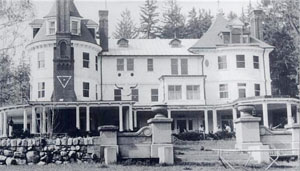 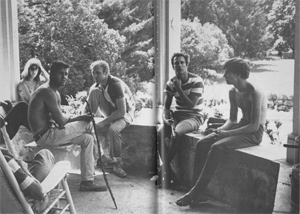
"Leary had set up the Castalia Foundation to explore the psychological and spiritual complexities of LSD use, and the Institute was located on the grounds of a mansion owned by William Hitchcock, a colleague of Leary's at Harvard. The Prankster Bus rolled up the long driveway unannounced, the Pranksters throwing green smoke bombs from the roof, blasting their crude music, and shouting from the windows. The visit was not the communal success Kesey had imagined. Leary briefly met the Pranksters, sat on the bus for a few minutes, and then retired to his room."
"Like the Pranksters Leary and his colleagues were exploring the social possibilities of the psychedelic drugs. But while the subject matter might be similar the method of exploration was different and there was some tension between the two groups. Describing the reactions the two groups had of each other Jay Stephens writes: 'What [the Pranksters] found was a bunch of Ivy League eggheads walking around in robes and talking like comparative religion professors...The Castalians regarded the Pranksters in their Day-Glo costumes, as the sort of thing that might happen if you put LSD in the punch at a Greek mixer-- a bad fraternity prank'."
Like a bad blind date, the visit was cut short.

The next day they were off, heading west.
"From the coolness of the east coast the Pranksters went by way of Calgary, Alberta to the hot tubs of the Esalen Institute in Big Sur, California."
"The Pranksters were back in La Honda by the end of August 1964 after having spent about $70,000 dollars and after having exposed some 50 hours of 16mm film and after having recorded endless hours of audio tape. The plan was to make a movie out of the recorded experience. But instead of making the movie the next Prankster project was to be the staging of the 'acid tests'."Perhaps this was a re-emergence of Dada Art Happenings, the cultural movement that began in Zürich, Switzerland, spread to the U.S. during World War I and peaked from 1916 to 1922.
"Freelance Journalist Hunter S. Thompson introduced Kesey to a group of Hell's Angels in July 1965. The Hell's Angels were as impressed with Kesey as he was with them, and in August Kesey hosted his first Acid Test with the Angels at his home in La Honda. Thompson believed it would be a disastrous mix. The Angels had never taken LSD, but after a night of wild revelry that approached insanity at times, the Hell's Angels rode away peacefully the following morning. The Merry Pranksters and the Hell's Angels would participate in numerous events together over the next two years."
"The journey came to an end in January 1966 at a 'Trips Festival' in San Francisco at which the Pranksters were expected to hold a 'Super Acid Test'. The show was brought to a premature conclusion by the police who arrested Kesey on various drugs-related charges.
After a short spell in Mexico, Kesey was eventually sentenced to six months for possession of marijuana. The other Merry Pranksters split up and went their separate ways, but their journey provided the inspiration and - such as it was - philosophy for the Hippie movement as it emerged in the mid-1960s."
"Tom Wolfe did not catch up with Ken Kesey and the Merry Pranksters until their long, strange journey was almost at an end. He met the elusive leader of the Merry Pranksters at the San Mateo county jail where Kesey ended up following his faked suicide and subsequent exile to Mexico. The psychedelic movement was just about to explode onto the world stage, and it was Kesey and his Pranksters who originated nearly every aspect of the new 'hippie' aesthetic bizarre dress, communal lifestyle, psychedelic drugs, light shows, and self-expressive rock and roll music. Tom Wolfe's breakneck, frenetic style captured the wild and turbulent years when the Merry Pranksters rambled across the country and back, hiding out in Mexico, and staging some of the most outrageous public events ever conceived."
•
"The Further Inquiry by Ken Kesey himself (1990) is a richly illustrated and highly original retelling of the first week or so on the bus, presented as a mock trial for Neal Cassady's spirit. Kesey had written about the Prankster era in his 'Garage Sale' anthology earlier (1973) but had not dealt with the 'Further' trip so explicitly. The case before the trial is the 'Stark Naked' mishap, concerning a young woman along for the bus ride who suffered a psychotic episode in Houston and had to be briefly hospitalized. This appears to have troubled Kesey long after, and the trial for Cassady's spirit is also a trial for Kesey himself, and the group's laissez-faire attitude, in view of the consequences it had for 'Stark Naked'.
"As courtroom observers we watch Mr. Kesey's exhibits of the archetypal Good Trip and the archetypal Bad Trip. We hear the story, told before by Tom Wolfe, of how Stark Naked got her name (at Larry McMurtry's house in Texas). With the court we ponder the fact that the Pranksters abandoned Stark, only phoning her boyfriend, Larry Hankin, to fly in from San Francisco, after the police picked her up because she was wandering, stoned out of her mind, with no more than a blanket around her shoulders.
On the witness stand in Kesey's mock trial, Stark Naked easily forgives them all, admits to being unstable in the first place and to being undone as much by her attraction to the hypnotic Neal Cassady as by any drug. One wonders whether this reassuring resolution bears any resemblance to the feelings of the real-life Stark Naked." (Cathryn Casamo)
"The trial does, however, end in true Prankster fashion, making the guilt question seem futile, and also signalling the 1990s resurrection of the group, which lead to a first-ever tour of Britain featuring many of the original key members - Ken Babbs, Mike Hagen, Kesey himself - present, plus Mountain Girl (Carolyn Adams) and a younger cadre of 'second generation' Pranksters. (http://hazardous.com/merlin)
"The 'Stark Naked' episode, along with almost everything else that occured on the 1964 'Further' journey, was documented with the Pranksters' tape recorders and still and movie cameras. In line with their 'movie' paradigm, more than 40 hours of film were shot during the bus trip for a vaguely defined documentary to be titled, The Merry Pranksters Search For The Kool Place. Long deemed uneditable, Kesey and Ken Babbs in particular worked on putting the raw material together into a comprehensible whole, and in 1999 the first part of the movie was made available to the public on video. Some 50 minutes long, in color with sound mostly in synch and occasional commentary from Kesey and Babbs, this unique document covers the early part of the journey during which many of the most infamous events occurred; the first LSD trip by an algae-covered lake in Wikieup, Arizona; the Stark Naked episode before and within Houston, the second LSD trip at a segregated beach in Louisiana during which the tripping Pranksters mistakenly visited the colored section and narrowly escaped a beating, encounters with unusual people and several policemen along the way, etc. The second part, which covers a visit in Manhattan and some beautiful footage from the Leary-Alpert scene at the Millbrook estate in rural New York, is equally entertaining and was released on video only a few months before Kesey's death in 2002."
•
"More balanced is the recollection offered in Ken Babbs's and Paul Perry's On The Bus: The Complete Guide to the Legendary Trip of Ken Kesey and the Merry Pranksters and the Birth of the Counterculture."
"In On the Bus Paul Perry also attempts to tell the story of Stark Naked and other acid casualties. The difference between the two books is that Mr. Kesey at least acknowledges the pain wrought along with the freaking fun, even if he is really building the case for the Pranksters' acquittal in the end. Mr. Perry treats even nightmarish incidents as no more than a momentary bummer in what were basically groovy times."
•
"A condescending, sensationalist account of Kesey and the Pranksters' adventures has been delivered by Tom Wolfe in The Electric Kool-Aid Acid Test."
"In the last [sic] chapter 'Stark Naked' lost her mind, and so the gang left her in Texas. The Pranksters exhibit both confusion and admiration about such behavior. They realize that the point of their whole journey is to reach the place where society and the rest of the world can be left behind. Their acid trips take them beyond the normalcy of the world, yet when they are confronted with the reality of someone who actually leaves the normalcy of the world for the realm of insanity, they are reluctant to keep her with them. They choose instead to abandon her and continue on their own way."
•
"'You’re either on the bus, or you're off the bus', became the metaphor for the Merry Pranksters and was repeated endlessly (you had to be there) on the long and now famous cross-country journey in the psychedelic bus, Furthur."
Cathy got back on the bus just before the trip to Mexico.
"In an attempt to stay free Kesey became an Outlaw and disappeared into Mexico, after a long drawn out Cat ‘n’ Mouse chase Kesey was eventually tried for possession of marijuana and sentenced to six months. Just before he went inside he moved The Bus up to Oregon."
"In 1969 Kesey went to England to work with the Beatles-owned Apple Records, a project involving albums of authors reading their own work. When it ultimately fell through, Kesey went back to the farm his brother had been tending all through the '60s.
There was one final temptation to leave: the Woodstock rock festival in the summer of '69. But as his bus filled up, Kesey decided not to go along. When those who went without him returned from the East, they were confronted by a sign Kesey had set up in the driveway. It said, simply: 'No!' The party was over.
Kesey subsequently threw the Pranksters off his property to fend for themselves, though some, notably buddies Ken Babbs, Mike Hagen and David Butkovich, settled nearby. Others moved to California, a couple of them defecting to the Jesus freaks. For the most part, the Pranksters have kept in touch. Only 'Stark Naked,' a girl whose loss to madness as described in Tom Wolfe's book, is unaccounted for (not anymore).
'Furthur,' as the Pranksters christened the bus, still sits in Kesey's front pasture. The psychedelic paint job has faded over the years. The seats have been ripped out, and baseball gear is stored inside. Cattle graze beside this cultural relic of the 1960s."
In 1991 Kesey came down from Oregon on his Further Inquiry book tour. The Smithsonian Institute wanted the Magic Bus for the museum, but it was deteriorating badly up on his ranch, so he built a new 2nd bus and headed out on his book tour. Cathy and I got on the bus in San Francisco and joined Kesey and friends for a
trip back down to the La Honda house where it all began.
A few days later, after his book reading in SF, the bus headed down to a party in Palo Alto. Cathy and I brought along two trusted friends, a photographic team, who wanted to record the journey. But on the way out of town, Kesey became uncomfortable with them and kicked us all off the bus...and once again Stark Naked was left behind.
The Merry Pranksters
Ken Kesey * "Chief" * Died 11/10/2001
(and the original 13)
Ken Babbs * Intrepid Traveler
John Babbs * Sometimes Missing
Ron Bevirt * Hassler
Steve Lambrecht* Zonker *
Died 9/9/1998
Jane Burton * Generally Famished
Cathy Casamo * Beauty Witch/Stark Naked * Died 12/12/1992
Neal Cassady * Speed Limit * Died 2/2/1968
Mike Hagen * Mal Function
Chuck Kesey * Brother Charlie
Dale Kesey * Highly Charged
Sandy Lehmann-Haupt * Dis-Mount * Died 10/29/2001
Paula Sundsten *
Gretchen Fetchin
George Walker * Hardly Visible
EPILOGUE
Ken Kesey’s original magic bus being restored
The 1939 International Harvester bus that author Ken Kesey and the Merry Pranksters drove into psychedelic history in 1964 sits on the Kesey family farm in Pleasant Hill, Ore. Stored in a swamp for 15 years, the bus has been hauled out for restoration.
Rainbow-painted ‘Further’ may yet run again.
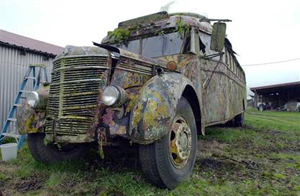
Jeff Barnard A/P
Jan. 20, 2006
PLEASANT HILL, Ore. - Zane Kesey picks at clumps of moss and swirls of brightly colored paint and patches of rust covering the school bus that his father, the late author Ken Kesey, rode cross-country with a refrigerator stocked with LSD-laced drinks in pursuit of a new art form.
“This comes off pretty easy,” Kesey says, a smile playing over his face. “It’s amazing, some of the things that are coming out — things I remember.”
He continues tidying the keepsake. “It’s going to take a lot of bubble gum,” he says.
For some 15 years, the 1939 International bus dubbed “Further” has rusted away in a swamp on the Kesey family’s Willamette Valley farm, out of sight if not out of mind, more memory than monument.
That is where Ken Kesey — author of “One Flew Over the Cuckoo’s Nest,” and hero of a generation that vowed to drop out and tune in with the help of LSD — intended it to stay after firing up a new bus in 1990.
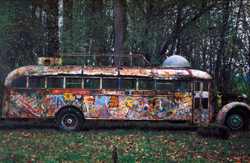 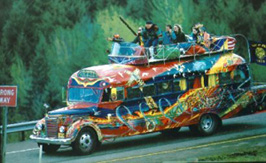
But four years after his death, a Hollywood restaurateur has persuaded the family to resurrect the old bus so it can help tell the story of Kesey, the Merry Pranksters and the psychedelic 1960s.
“I read his books back in high school and through college,” says David Houston, owner of the historic roadhouse Barney’s Beanery in Los Angeles. “I just always thought he was a fascinating and brilliant man. The story of the bus was always very compelling. To find out it had been just left to go — I really wanted to restore the bus and tell its story to the world.”
Houston hopes to raise the $100,000 he figures it will cost to get the bus running and looking good. The Kesey family will maintain control of the bus, though, taking it to special events.
“People think of a bus as transportation,” Zane Kesey says. “No. It’s a platform, a way to get your messages across.”
Tough job ahead
Last fall, a group of old Pranksters hauled the bus out of the swamp and parked it next to a barn to await restoration.
“One of the things that is really optimistic for me is it’s got full air in the tires from Cassady,” says Kesey, referring to Neal Cassady. “Honestly, if the tires had been flat, I would have said, ‘Just leave it there.”’
The restoration will be a tough job. On a cold misty day, Houston, Zane Kesey and former Green Turtle bus mechanic Mike Cobiskey climb on ladders, peer under the hood, pick at paint and crawl underneath to look it over.
What they see is daunting. The body is badly rusted. The paint is peeled. The roof leaks. The engine, not original, and transmission have both been underwater. The original bunk beds and refrigerator are gone, but the driver’s seat remains.
“The most important thing is the paint,” Cobiskey says to Kesey. “I’m sure you have a thousand pictures of it.”
“And no two are alike,” Kesey replies.
“It’s gonna go,” says Houston. “It can definitely run. It shouldn’t drive across country. But certainly it should be a living, healthy, valuable piece once we are done with it.”
Bob Santelli, artistic director of the Experience Music Project in Seattle, tried to raise money to restore Further in 1996 when he was at the Rock and Roll Hall of Fame and Museum in Cleveland, but couldn’t swing it. He did get Kesey to bring the newer incarnation to the museum.
“I consider the bus to be one of the most important icons of the ’60s Counter Culture,” says Santelli. “Inside that bus occurred many of the things the counter culture was all about, from a revolutionary perspective. That is mobility, freedom to be on the move, and to react to situations and create situations to react to, drug use and experimenting with drugs, and the importance of music in a cultural revolution.”...
“For me and Kesey, too, we were trying to move into a new creative expression which was movie making, and being part of the movie,” Babbs says. “This was all a tremendous experiment in the arts. We always figured we would be totally successful and make a lot of money out of it.”...
...“When people ask what my best work is, it’s the bus,” Ken Kesey said in 2000. “Those books made it possible for the bus to become.
“I thought you ought to be living your art, rather than stepping back and describing it,” he said. The bus is “a metaphor that’s instantly comprehensible. Every kid understands it. It’s like John Ford‘s ‘Stagecoach’ with John Wayne in the driver’s seat just like Cowboy Neal.”
After one last trip, to Woodstock, N.Y., in 1969, Kesey put the bus out to pasture, where it served as a dugout for softball games. The Smithsonian Institution in Washington, D.C., expressed some interest in restoring the bus, but Kesey would never let it go. He towed it to the swamp in 1990 when he bought a 1947 bus for a whole new series of trips.
“People were always saying, ‘Is this the real bus?”’ Babbs says. “And he would say, ‘Yes, there’s only one bus, just like there’s only one Starship Enterprise.”’
Kesey’s widow, Faye, had reservations about restoring the old bus, but did not try to stop it.
“I kind of liked it in the swamp covered with moss and becoming part of the swamp,” she said. “But I talked to everybody who had been on it. To a man they all wanted to see it restored.
“If not, it can always go back to the swamp. Nature does a pretty good paint job, too.”
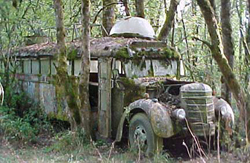
This story was cobbled together by Stephen Ehret
from various works of the following writers.
These are live links to the source
:
Ken Babbs
Larry Hankin
© 2002 Larry McMurtry/NY Review of Books
© 1998 by the Rector and Visitors of the University of Virginia
© Copyright of Telegraph Media Group Limited 2001
© 1996 by the Cosmic Baseball Association
Patrick "The Lama" Lundborg
Deirdre English: NY Times December 9, 1990
John Riley: People Magazine March 22, 1976
© 2009 The Associated Press.
© 1999-2002 pooterland.com
© 1999-2010 Gradesaver
Dominick Cavallo
Easy Riders
myself
with the assistance of
Larry Hankin, Ron Bevirt, George Walker, Mike Hagen and Ken Babbs
Photographs by Ron Bevirt, Gene Anthony, Allen Ginsberg, Brian Lanker and Jeff Barnard
editing by Cynthia Franco
|